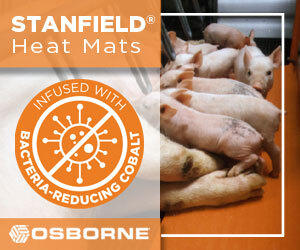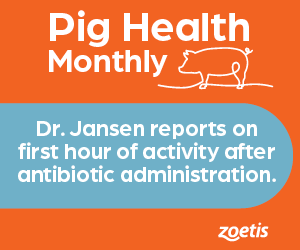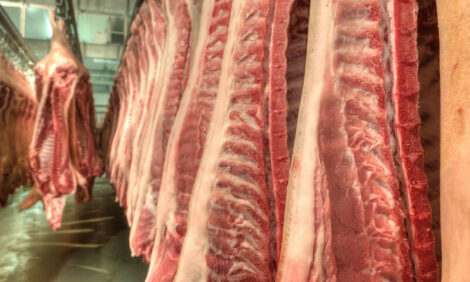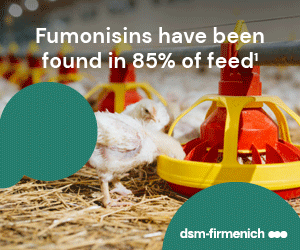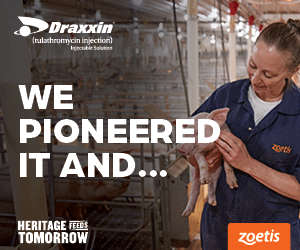



Evaluating Breeds of Swine for Crossbreeding Programs
Archie C. Clutter (Assistant Professor, Animal Science), David S. Buchanan (Professor, Animal Science) and William G. Luce (Extension Swine Specialist), explain crossbreeding, heterosis and the effects on performance and carcass traits in this Fact Sheet from Oklahoma Cooperative Extension Service, published in July 2007.Crossbreeding is a widely accepted and recommended practice in commercial swine production. It is used to capitalize on heterosis, the superiority of crossbred individuals over the average of their purebred counterparts. An example of heterosis is shown in Figure 1. Crossbred performance may be more or less than the performance of the best purebred, depending on the breeds crossed. For there to be heterosis, crossbred performance must be above the average of the pure breeds.
Heterosis
Heterosis occurs when breeds are crossed. Heterosis tends to be largest for traits with low heritability such as litter size, litter weaning weight, and pig survival rate (Table 1). Growth trails are moderately heritable but are also improved by crossing, especially average daily gain and age at 220 pounds. Carcass traits, however, are highly heritable and benefit little from heterosis.

Increased pig survival and growth rate are the main benefits of a systematic crossbreeding program. When a boar of a different breed is used on purebred dams, litter size born is not significantly increased (Table 1). However, crossbred pigs have a higher survival rate than purebreds. Thus, at weaning two-breed cross litters are 11.3% heavier than purebred litters. In addition, crossbred pigs reach 220 lb 6.5% faster on 2.3% less feed per lb of gain. Little heterosis exists for carcass traits; therefore, carcass merit of crossbred pigs is expected to be equal to the average of the purebreds.

The maximum advantage of crossbreeding is realized when a crossbred sow is used. An additional increase of 8.7% in litter size weaned can be expected (Table 1). This improvement is due to an additional increase in the number of pigs born alive (4.7%) and a higher survival rate of the pigs. The total reproductive advantage of crossbred sows over purebred sows results in 29% greater 21-day litter weights per female exposed for crossbred sows with crossbred pigs as compared to purebred sows with purebred pigs.
There is also a substantial benefit in conception rate when a crossbred boar is used. This benefit is most profound for young boars. Research conducted at the Oklahoma Agricultural Experimental Station showed a 17.1% crossbred boar advantage in conception rate at first service and a 3.4% advantage for an eight-week breeding season. Use of crossbred boars had very little effect on litter size, on weight, growth rate, backfat thickness, or feed efficiency. Use of crossbred boars would allow a smaller gilt pool to be maintained and result in a more rapid return to production following weaning.
This could be accomplished without negative impact on other performance traits. Crossbreeding increased litter size, pig survival, and growth. Some improvement in feed efficiency is realized, but carcass traits show little heterosis. Overall efficiency and improvement in these characteristics is made by selecting superior parents. Real breed differences exist for nearly all traits. Therefore, the choice of breeds and their use in a systematic way is critical in a crossbreeding program. For a discussion of crossbreeding systems, see OSU Extension Fact Sheet ANSI-3603, “Swine Crossbreeding Systems.”
Breed Evaluation
Choice of breeds for systematic crossbreeding programs should be based on the average differences between breeds in controlled experiments. The genetic composition of breeds and the frequency of desirable gene combinations do change over time, although the process is quite slow. Therefore, breed selection should be based on recent research.
Results of crossbreeding studies conducted since 1970 in Iowa, Oklahoma, North Carolina, and Canada are summarized in Tables 2 through 4. All breed combinations have not been adequately compared and numbers are limited for some breeds. The data are useful, however, in making breed selections for systematic crossing sequences. Recommendations are not meant to eliminate those breeds which have not been adequately compared.
A summary of crossbreeding experiments is given in Table 2. These results suggest that Chester White females are superior for litter size at birth and weaning, 21-day litter weight, and 21-day litter weight per female exposed. Yorkshire females rank second to Chester Whites for litter size born and weaned and 21-day litter weight. The high conception rate for Hampshire females causes them to have a relatively high 21-day litter weight per female exposed.
The commercial producer should be primarily concerned with the productivity of crossbred females of various breeding, since crossbred females are superior for reproductive efficiencies. Table 3 ranks 16 different crossbred female types. Hampshire x Landrace crossbred females had the highest ranking for litter size at birth and 21 days and litter 21-day weight.
The Chester White x Yorkshire females had the heaviest 21-day litter weight per female exposed because of their high conception rate. In general, females with Landrace, Yorkshire and Chester White breeding were superior in mothering ability to those with predominantly Duroc, Hampshire, and Spot breeding.



Sire Breeds
Experimental results have shown that the breed of sire can influence the sow’s reproductive performance to which they are mated. Females mated to Yorkshire boars ranked high compared to the other breeds evaluated. It appears that sire breed does not have any major influence on litter size at birth, but there were large differences apparent in litter size at weaning and 21-day litter weight per female exposed.
Sires continued to influence the post weaning performance of pigs. Duroc sired pigs had an advantage for growth rate and Hampshire sired pigs were found to be superior for carcass merit (Table 4). Regardless of the choice of breed, boars from large litters with superior individual performance for growth, feed efficiency, and carcass merit should be used.
February 2009







